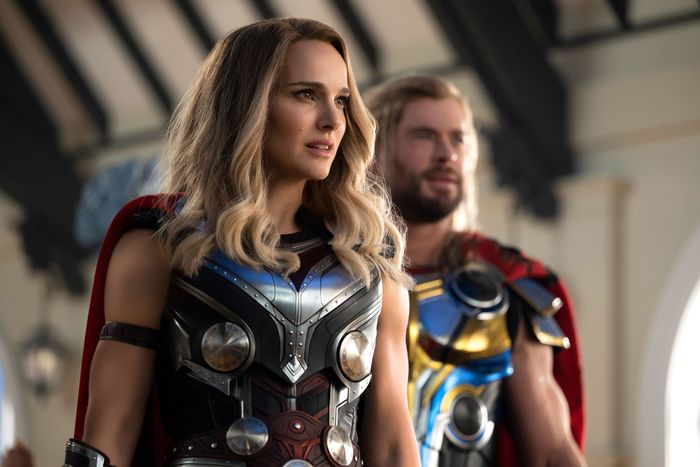
When Natalie Portman turns up in full Thor drag — winged helmet and vermillion cape, her biceps freshly swole — in Thor: Love and Thunder, the biggest shock for some Marvel-cinematic-universe completists won’t be that her all-too-human character Jane Foster suddenly, mysteriously possesses the ability to heft the superhero-god-Avenger’s unliftable hammer Mjolnir. It will be that the Academy Award–winning actress returned to the role at all.
In 2011, Portman — Marvel’s first female lead in the first Thor — reportedly became “furious” with the studio ahead of production on the second stand-alone installment. And after fulfilling her contractual obligation to appear in the craptacularly reviewed Thor: The Dark World, she told the Wall Street Journal, “As far as I know, I’m done” with the MCU. Indeed, her astrophysicist doctoral character remained notably absent from the first three Avengers movies and was written out of 2017’s Thor: Ragnarok.
In the intervening years, reports that Portman declined to show up for reshoots on The Dark World highlighted one of the scant few rifts between the hitmaking studio and top talent ever to spill into public consciousness (the others, of course, being writer-director Edgar Wright ditching Ant-Man over “creative differences” with Marvel and star-slash-uncredited rewrite man Edward Norton attempting to strong-arm final cut on The Incredible Hulk). And yet at the 2019 San Diego Comic-Con, the Black Swan actress shocked Hall H by arriving onstage with Mjolnir to announce she would not only be returning to the franchise but that Jane Foster would assume the mantle of the Mighty Thor in Love and Thunder.
Portman’s unlikely ascension to Asgard, seeming repudiation of her niche in the Marvel cinematic universe and return to prominence within it — as Natalie Thortman, if you will — provides a fascinating glimpse into the workings of what we can fairly call post-multiverse Hollywood. A weird creative cauldron in which beloved characters can disappear on a whim only to be endlessly resurrected, a magic kingdom where the right IP is a cure to all perceived evils and resistance toward filmdom’s most successful studio division is ultimately futile.
Five-foot-three, petite, and cerebral enough to complete an undergraduate degree at Harvard, Portman was never an obvious romantic foil for hulking, heavy-metal-haired six-foot-three Australian Chris Hemsworth (who was basically unknown). Further, outside of a trilogy of poorly regarded Star Wars sequels, her cinematic pedigree at the time of her casting skewed toward the arty and even obscure. She has said — perhaps jokingly but probably not — in interviews that she was handed the role to make Hemsworth look all the more enormous onscreen. But her hiring helped establish a now boilerplate Marvel move of surrounding their super-suited heroes with prestige performers (it helps to remember Stellan Skarsgård, Cate Blanchett, Anthony Hopkins, and now Christian Bale have all participated in the borderline absurdity of Thor movies, too.)
On the heels of Thor’s successful if not outright blockbuster release ($449.3 million in ticket sales on a $150 million budget), Portman more fully invested herself as a franchise player. She lobbied Marvel for Patty Jenkins — the filmmaker behind the 2003 bio-drama Monster, which yielded Charlize Theron’s Best Actress Oscar — to direct The Dark World after the original Thor director, Kenneth Branagh, decided the sequel was not for him. Jenkins would have become the first woman to helm a superhero event movie, and Portman, who had her first child that year, was said to have become reinvested in her role — and in acting altogether — thanks to the director’s energy.
What happened next is a matter of dispute. According to a story in The Hollywood Reporter, Marvel became disenchanted with Jenkins for showing a “lack of overall clarity in her choices” which led to apprehension the production would be “difficult.” (Sources close to Jenkins denied this.) There were other reports the studio was concerned the filmmaker wasn’t moving fast enough ahead of the beginning of principal photography and was on track to blow The Dark World’s November 2013 release date. Jenkins claimed to have bailed on her own initiative: “I did not believe I could make a good movie out of the script that they were planning on doing,” the director said in 2020. “It would have looked like it was my fault.” Whatever the case, Marvel unceremoniously dumped Jenkins, who went on to direct Wonder Woman, without first giving Portman a heads-up. When she read the news, the actress was reportedly livid.
None of this castle intrigue is immediately apparent when you watch The Dark World, which was directed by Game of Thrones veteran Alan Taylor and is generally regarded as one of the MCU’s weakest entries. Portman mostly fulfilled her sequelization duties. But when she was called back for reshoots, the Oscar winner left Marvel high and dry — she cited scheduling conflicts — which resulted in Hemsworth recruiting his real-life wife Elsa Pataky to stand in for Portman in a scene where Jane and Thor make out. “So they put his wife in my wig and costume,” Portman told Us. “That’s why it was so passionate.”
Over the years, Marvel head honcho Kevin Feige has downplayed any acrimony between Portman and the studio, explaining she had been left out of Thor: Ragnarok simply because the movie is set in outer space. But her blink-and-you-missed-it appearance in 2019’s Avengers: Endgame signaled the possibility of détente; Jane shows up in Asgard during a flashback sequence in which Thor travels through time. Never mind that the footage of Portman was actually leftover from The Dark World or that her contribution to the biggest blockbuster in history was a single line of voice-over. Marvel fans rejoiced that she was back in the fold.
But it ultimately took Taika Waititi to persuade her to appear in Thor 4. Returning to the franchise after having directed the $854 million–grossing Ragnarok, the Oscar-winning writer-director pitched Portman on the idea of transcending her Jane-ness to play a kind of parallel version of the God of Thunder: a hero in her own right who comes to possess all the superhuman strength, bravery, intergalactic fluency, and hammer-wielding prowess of her ex-boyfriend. “You don’t want Natalie coming back and playing the same character who’s walking around with science equipment,” he told Empire. “You know while Thor’s flying around, she’s left on Earth, tapping her foot going, ‘When’s he going to be back?’ That’s boring. You want her to be part of the adventure.”
Since her start with the Norse god, Portman has alternately tried to show her serious side. She directed and starred in the heartfelt war drama A Tale of Love and Darkness, landed another Oscar nod portraying Jacqueline Kennedy in 2016’s Jackie, and received raves as an awestruck astronaut in Noah Hawley’s ponderous Lucy in the Sky. The actress credits Waititi’s comics-based yet implicitly feminist approach to recasting her character for the change of heart. “He came with the comic books where Jane becomes the Mighty Thor and was like, ‘What do you think about this?’” she told IndieWire. “So it was this kind of twofold opportunity, one to work with him and the other to have Jane evolve into this superhero, which was really exciting.” Thunderous, even.





